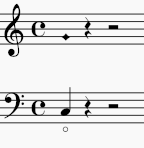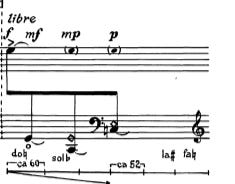Hi friends,
I didn’t plan for the harp tips emails to be on this long of a hiatus, but at least I’m getting one in during Q1! This past week, I answered an email question about non-octave (or higher partial) harmonics and thought I would share that answer with you (along with some examples).
In this email:
Harp Tip: How to notate non-octave harmonics
Score Reviews and Consults-coming soon
Harp Writing for Composers course update
Q&A (submit some questions!)
Harp Tip: How to notate non-octave harmonics
Non-octave (or higher-partial) harmonics (12ths, 15ths, and 17ths) are available for a small range of strings on the harp. We’ll discuss some notation suggestions; however, since that is a non-standard technique, I would always recommend including a performance note on the specific notation that you decide to use.
For regular octave harmonics, the recommended notation is to write the harmonic at played pitch (an octave lower than sounding pitch).

For non-octave harmonics, you will want to notate both the played pitch AND the sounding pitch. A common notation is to use a standard notehead for the played pitch and a diamond notehead without a stem for the sounding pitch. You could also explore using different notehead shapes for certain partials.

The Holliger Sequenza offers an additional option of notating the sounding pitch at 8vb, plus the actual sounding pitch.

Thomas Goss (from Orchestration Online) put together a helpful blog post that references a collaboration I did on a piece with Kincaid Rabb that uses non-octave harmonics. Here are the links for Part 1 and Part 2. Part 1 includes a helpful chart of the available harmonics and Part 2 discusses some notation strategies.
The video below includes a chapter on non-octave harmonics (16:52) with demonstrations and notation examples:
Non-octave harmonics can also be done on the lever harp. While the available ranges should still work, you may want to stick with the mid ranges, just to be safe. Pedal harp string tension is fairly standardized, but lever harp size and string tension can vary widely. So, unless you are writing for a specific lever harp (or harpist!), I would error on the conservative side for non-octave harmonics.
Score Reviews and Consults-coming soon
If you’ve been interested in getting feedback on your harp writing, either through a score review or Zoom consult, I hope to offer these again next month. I’ll likely only offer a limited number each month (due to the new baby), so if you have a specific project or deadline in mind, feel free to go ahead and reach out via email. I’ll prioritize those requests first before I reopen the reviews for purchase on my website.
Harp Writing for Composers course update
My course, Harp Writing for Composers, has been on hiatus for the past year, but I’m excited to announce that enrollment is again open! This course is designed for composers with little to no experience writing for the harp and covers the essential principles of composing effectively for the modern pedal harp.
This course is self-guided with 5 video modules, includes guided prompts on writing a harp solo, AND includes feedback from me on your solo upon completion. Each module should take you 1-2 hours and it is recommended to complete the course within 5-6 weeks. However, you will have lifetime access to all the material in the course (plus any future updates), as well as access to periodic alumni-only Zoom workshops and office hours.
Feel free to email with any questions!
Q&A
Do you have questions about writing for the harp? Submit your question here for the Q&A column of this newsletter! I’m also planning out my next batch of YouTube tutorials, so feel free to submit topic requests for those as well.
Until next time,
Danielle
Danielle Kuntz, MM, BM Harpist | New Music Curator
Copyright © 2025 Danielle Kuntz, All rights reserved.




